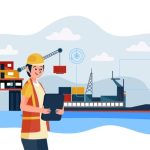A diffuser is a Round plate with a circular hole in the middle, and a number of radial grooves, which is placed in front of a jet atomizer of a boiler.
The function of diffuser or as normally called, swirler plate is to mix the air and fuel properly. There are radial cuts in the diffuser plate which will create a vortex flow of the air . Atomizer is directed into the middle hole of the diffuser. When the Combustion fan directs air into the diffuser, it creates a vortex flow. The atomizer nozzle directs the fuel into this vortex, which gets evenly mixed with the air. The flame stablity is greatly related to the cleanliness of the diffuser plate.
When the diffuser plate becomes dirty, mostly due to carbon and fuel particles sticking to it, the radial cuts in the plate are blocked. In this condition, the air supply to the boiler burner becomes low, and Boiler starts tripping at high loads. The air- fuel ratio cannot be maintained under a dirty diffuser condition. This further creates more carbon accumulation which may eventually fully block the diffuser swirler action, and failing the boiler even at low loads. This is a major reason why a boiler fires reasonably good under low load and trips under high loads, mainly above 70%. This is my personal experience onboard my vessel, where my boiler was tripping at 70%+ loads. Inspection of diffuser revealed considerable cabron accumulation. Once cleared boiler was firing normally under all loads.
To prevent the blockage of diffuser plate, always keep good fuel- air ratios.
A small carbon accumulation can accelerate the spoiling of the plate.
Keep ur diffuser plates clean and have a happy boiler my sailor friends:) happy sailing.
How to Blow down a boiler
Boiler blow down is one of most important routine jobs done on a main or aux boiler onboard a ship. I have a AALBORG MISSION OC- 2000 Kg/hr steam composite boiler and ALBORG MISSON OC- 20000 Kg/hr aux boiler onboard the vessel i am currently onboard. The boilers are being blown down regularly, when the water tests show an increased chlorine level , when conductivity increases ,or when the boiler water colour changes to reddish brown.
Blow down is needed to remove the sediments which get accumulated in the water ring on the boiler or when chlorine levels increase due to bad quality feed water ( when fresh water generator salinty is high).
PROCESURE TO BLOW DOWN:
1. Keep boiler firing ( this way you will have a better circulation of water inside the boiler)
2. Normally 2 valves are given on boiler side and 2 valves on the sea side for blowdown purpose. The idea behind giving two valves for blowdown in each of the places is that, The valves attached to the ships hull and the boiler body are very difficult to overhaul, when ship is sailing or in port. These valves can be overhauled when ship is in dock only( by adjusting list or blowing down entire boiler you can do this , but you know how hard it is :P). So normally dont play around with these valves and dont keep them throttled( throttling a steam valve or a high pressure line valve causes wire drawing effect which destroys valve seats and it starts leaking). Now, you need to control flow rate for blowing down, and how do u achieve that??? Throttle the valve which is not attached to the boiler body or the ships hull!! This is why 2 valves are given .
3.Open the valve attached to the ships hull and the boiler body fully first.
4.Open the sea side valve .
5.Throttle the flow rate using the second valve given after the valve attached to boiler body. Simple!!!
6. When water level reaches the normal level on guage glass, close the throttled valve first( see which valve is throttled from point no.5)
7. Close other valves. 8. Finish the blowdown.
This is my practise.. if u guys have any new ideas or suggestion please don’t forget to leave them in comments. Happy sailing 🙂



Comments are closed